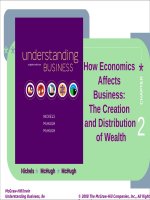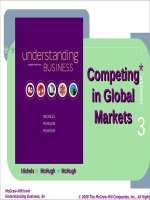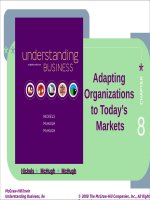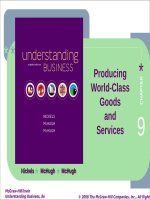Understanding business 11th by mchugh nickels CHAPTER 3
Bạn đang xem bản rút gọn của tài liệu. Xem và tải ngay bản đầy đủ của tài liệu tại đây (6.23 MB, 70 trang )
CHAPTER 3
Doing
Business in
Global
Markets
McGraw-Hill/Irwin
Copyright © 2015 by the McGraw-Hill Companies, Inc. All rights reserved.
NAME that COMPANY
This Swissbased company has many foreign
subsidiaries including Jenny Craig (weight
management), Ralston Purina, Chef America
(maker of Hot Pockets) and Dreyer’s Ice Cream
in the United States as well as Perrier in France.
The company employs over 328,000 people and
has operations in almost every country in the
world.
Name that company!
1-2
BUSINESS in the
GLOBAL MARKET
LO 31
• Over 90% of companies
doing business globally
believe it is important
for employees to have
international
experience.
• U.S. organizations (like
UPS, MLB, the NFL and
the NBA) are also
expanding abroad.
3-3
WORLD POPULATION
by CONTINENT
LO 31
3-4
WORLD POPULATION
GROWTH
LO 31
3-5
IMPORTING and EXPORTING
LO 31
• Importing Buying products
from another country.
• Exporting Selling products
to another country.
• The U.S. is the largest
importing and the second
largest exporting nation in
the world.
3-6
CAN YOU SPARE a DIME?
LO 31
Home Countries for Some of the World’s Billionaires
• U.S. – 516 billionaires
• China – 136 billionaires
• Russia – 88 billionaires
• Germany – 82 billionaires
• India – 54 billionaires
• U.K. – 43 billionaires
• Hong Kong – 41 billionaires
Source: Forbes, www.forbes.com, accessed November 2014.
3-8
TRADING with OTHER NATIONS
LO 31
• Countries with abundant natural resources (like
Venezuela or Russia) need technological
resources from other countries (like Japan).
• Global trade allows countries to produce what
they make best and buy what they need from
others.
• Free Trade The movement of goods and services
among nations without political or economic barriers.
3-9
Company % of
Earnings From Outside U.S.
Source: Investment Advisor,
Advisor, August 2000
3-10
COMPARATIVE and ABSOLUTE
ADVANTAGE
3-11
COMPARATIVE ADVANTAGE
• Comparative Advantage A country should sell the
products it produces most efficiently and buy from other
countries the products it cannot produce as efficiently.
3-12
COMPARATIVE ADVANTAGE
U. S.
China
China
3-13
Softwar
e
U. S.
Clothin
g
ABSOLUTE ADVANTAGE
• Absolute Advantage A country has a monopoly on
producing a specific product or is able to produce it
more efficiently than all other countries.
3-14
ABSOLUTE ADVANTAGE
Absolute = Virtual Monopoly
South
Africa
The Rest of
the World
3-15
Diamond
Production
GOING GLOBAL with a
SMALL BUSINESS
LO 32
• Small businesses
may be the key in
global job growth.
• Only 1% of U.S. small
businesses export,
yet they account for
30% of total U.S.
exports.
3-16
WHOM DOES the U.S. OWE?
LO 32
Countries that Own the Most U.S. Debt
Source: Max Fisher, Washington Post, www.washingtonpost.com, accessed November 2014.
3-17
GETTING INVOLVED in
IMPORTING
• Students attending schools
abroad tend to notice
products that they’re used
to are unavailable in their
new country.
• By working with producers
in their native country,
some become importers
while still in school.
3-18
GETTING INVOLVED in
EXPORTING
LO 32
• Exporting provides a
great boost to the U.S.
economy.
• It’s estimated every $1
billion in U.S. exports
generate over 7,000
U.S. jobs.
3-19
MEASURING GLOBAL TRADE
3-20
HOW to MEASURE GLOBAL TRADE
• Balance of Trade The total value of a nation’s
exports compared to its imports measured over a
particular period.
• Trade Surplus (Favorable) When the value of a
country’s exports is more than that of its imports.
• Trade Deficit (Unfavorable) When the value of a
country’s exports is less than that of its imports.
3-21
HOW to MEASURE GLOBAL TRADE
/>
3-22
BALANCE of PAYMENTS
• Balance of Payments The difference between
money coming into a country (from exports) and
money leaving the country (from imports) plus other
money flows.
• The goal is to have more money flowing into a
country than out – a favorable balance.
• An unfavorable balance is when more money
flows out of a country.
3-23
UNFAIR TRADE PRACTICES
• Dumping Selling products in a foreign country at
lower prices than those charged in the producing
country.
• Dumping is prohibited.
• China, Brazil and Russia have been penalized for
dumping steel in the U.S.
3-24
LARGEST EXPORTING NATIONS
and TRADE PARTNERS
LO 32
3-25
TEST PREP
• What are two of the main arguments favoring the
expansion of U.S. businesses into global
markets?
• What is comparative advantage, and what are
some examples of this concept at work in the
United States?
• How are a nation’s balance of trade and balance
of payments determined?
• What is meant by dumping in global trade?
3-26









